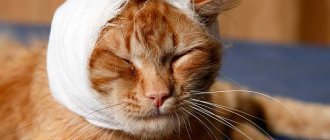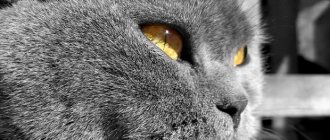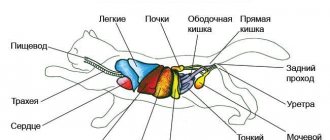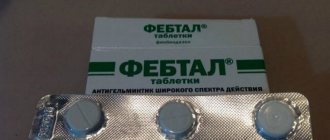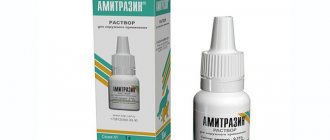Instructions for use
To treat kittens, a microenema is administered using a syringe. The optimal dosage is calculated based on the baby’s weight - per 100 g there is from 0.1 to 0.2 ml of the drug. For an adult cat, the child dose is ½ tube. Veterinarians recommend lubricating the tip of a syringe or microenema with liniment, for example, Vaseline ointment, so as not to damage the pet’s anus. An alternative method is to attach a tube from a dropper, which is made of silicone. To give your cat an enema without causing too much stress, veterinarians recommend following these tips:
- The microenema is performed by two people, since one person may not be able to hold a suddenly lunging pet.
- It is necessary to maintain composure and not show anxiety, otherwise the kitten may be frightened.
- Before the procedure, you need to relax the animal as much as possible, for example, you can comb it or let it smell special cat pheromones.
- During the administration of liquid, it is recommended to stroke the animal and also speak to it in a calm, soothing tone. Cats react to their owners' intonations, not the meaning of words.
The owner should be nearby until the animal has a bowel movement.
After introducing the viscous liquid into the intestine, you need to fix the cat’s tail at the anus for 2-3 minutes.
The instructions for use recommend staying next to the animal for the next hour in order to examine the feces after bowel movement. There may be individual red or brown fibers in the waste, since fecal stagnation damages small intestinal vessels, but blood is a dangerous sign indicating the need to quickly transport the cat to a veterinarian.
Enema technique
The key to successfully performing an enema on a suffering cat is to follow the procedure recommended by veterinarians.
For males, the best position for enema is standing on their paws. The person squats, the animal presses tightly to the body, the tail rises. The head of the cat, which can bite if it resists, is placed in the palm of your hand; it is also advisable to fix it gently but securely.
Technique for restraining a cat during an enema
During the procedure, you need to speak kindly to the animal, calming it as much as possible, reducing stress from unpleasant and frightening manipulations.
The enema tip, pre-lubricated with Vaseline, is inserted very slowly into the anus with rotational movements. The maximum insertion depth is 3-5 cm, after which the enema will touch the compressed feces. Gradually, the contents of the syringe or syringe are released into the small intestine, and the anus is clamped by the animal’s own tail. You should persuade your pet to wait a couple of tens of minutes so that all the feces dissolve and come out of the intestines with ease. At this time, you need to gently massage his tummy in the pelvic area with an open palm, which will promote better distribution of the medicinal fluid in the abdominal cavity.
It is best for females to give an enema while lying on their side or in a bathtub, or in a wide pelvis, pressing it firmly to the surface. The procedure is similar to enema males.
Important! If resistance occurs when squeezing liquid out of the syringe, the procedure should be stopped and the animal examined for the presence of a tumor or foreign bodies in the intestine. Rapid fluid administration is unacceptable, as this can lead to rectal injuries.
After a good massage, the animal begins to defecate within 10 minutes, however, with severe and prolonged constipation, you will have to wait a couple of hours. If the result is not achieved, after 3 hours you can repeat the enema.
It is imperative to monitor whether there are any clots or streaks of blood in the excreted stool; this signals intestinal injuries that should be urgently treated by a veterinarian.
Small restless kittens are turned with their heads towards themselves and their bodies are pinched between the knees in the back area. The baby should be held firmly, but most importantly, do not put too much pressure on the throat. In addition to the enema tip (smaller in diameter than for adult animals), the cat’s anus is also generously lubricated. For kittens, a sufficient depth of insertion will be 1-2 cm, since their intestines are short.
Contraindications and adverse reactions
Veterinarians note that the maximum permissible number of Microlax enemas is 2 within 2 days. If there is no effect, you need to go to the doctor.
Negative reactions after the procedure are rare, but sometimes a pet may experience the following symptoms:
- nervous meowing;
- rushing around the apartment;
- diarrhea;
- pain when pressing on the stomach;
- allergic reaction.
If a cat has gastrointestinal pathologies, cracks and ulcers in the intestines, then veterinarians prohibit the use of any laxatives. Microlax should not be used for intestinal obstruction, which often occurs in pets due to the ingestion of large amounts of wool mats and foreign bodies. The consequence will be a deterioration in the animal's condition. Intestinal volvulus is also a contraindication to the use of the medication, because this disease requires urgent surgical intervention before necrosis of intestinal tissue begins due to impaired blood flow. It is prohibited to give an enema to a cat after sterilization or other surgery that has recently been performed, as it can cause rupture of the sutures and internal bleeding.
LiveInternetLiveInternet
Your_Veterinarian_Doctor all posts by the author
Constipation in cats is a fairly common phenomenon, associated primarily with ingestion of fur during constant licking, as well as with poor diet. Constipation is the name given to difficult, infrequent or absent bowel movements (bowel movements), in which stool accumulates and hardens in the colon. Simply put, constipation is a retention of stool that causes pain and discomfort to the animal. Normally, a healthy cat should have stool once every 1-2 days. Constipation is difficult to miss - a cat suffering from it is lethargic, lacks appetite, and may experience nausea and vomiting. At the same time, the animal’s stomach is swollen, and attempts to empty the intestines are painful and difficult (or fail at all). The consequences of constipation can be very unpleasant. The process occurring in the large intestine is accompanied by the formation of harmful substances, which must be excreted over a certain period of time. With constipation, they remain inside and poison the body, exposing it to intoxication by decay products. As a result, this negatively affects all organs: the functions of the kidneys and liver are impaired, the load on the heart increases, and problems with the skin and coat begin. In especially severe cases, in the absence of timely help, constipation can even lead to death for the animal. To provide your cat with effective help for constipation, it is first important to establish its causes, which can be very diverse. What are the causes of constipation in cats? Animals suffering from diseases of the rectum, intestines, anus, kidneys and liver, and those with neurological and orthopedic disorders are susceptible to constipation. This problem is more common in older animals than in young ones, and is also more common in cats than in cats. Among the causes of irregular painful bowel movements may be the following conditions: * foreign body ingestion (for example, ingestion of bones, foreign objects); * fur accumulated during licking (trichobezoar); * unbalanced diet; * perineal hernia; * inflammatory processes in the rectum and anus; * difficulties in taking a comfortable position for bowel movements due to orthopedic problems; * narrowed anus due to scars (stricture); * diseases of the paranal glands; * intestinal diseases (megacolon - a strong increase in volume and a decrease in motility); * inflammatory diseases, tumors, hyperplasia, etc. In cases where gentle treatments at home do not help and the animal continues to suffer from constipation, it is worth contacting a veterinarian who will help determine the reasons for the deviation from the norm. To do this, he will conduct an examination, give the cat an enema, and, if necessary, prescribe a blood test, an X-ray with a contrast agent, or an ultrasound of the abdominal cavity. How to deal with constipation in a cat at home? If there are periodic problems with bowel movements, the animal is given products that help soften the stool. As a rule, these are lactulose preparations, such as Duphalac, Lactusan and others, as well as petroleum jelly. * Vaseline oil is given orally two to three times a day, 5-50 ml (the dose is selected individually) until the stool returns to normal. Its effect is associated with the softening of feces and lubrication of the intestinal walls, which helps the animal to empty it. Vaseline oil is practically harmless to the body and is almost not absorbed. It is not recommended to use various vegetable oils instead - they are actively absorbed by the intestines, without reaching the feces, and when consumed in large quantities they negatively affect the liver. * Duphalac is given twice a day, 2 - 2.5 ml. The dose is selected at the rate of 0.5 ml per kilogram of animal weight (the average weight of an adult cat is 3–5 kg). * A mixture of condensed milk and raw water is a fairly common folk method of combating constipation in cats. Drinking this drink helps soften stool and normalize bowel movements. But still, doctors do not recommend using this method. * Laxatives are used in dosage according to the instructions (for example, Sodium Picosulfate). It is advisable that the medications be prescribed by a veterinarian. It is not recommended to use common castor oil - this can lead to severe pain in the cat and will not give the desired result. * Drugs that help normalize intestinal microflora - prescribed in courses or for continuous use. If constipation does not go away, and the animal’s condition worsens, it is necessary to do a deep cleansing enema. This is not the easiest procedure (rinsing may require 5-8 liters of water), so you must contact a veterinarian to perform it. You can try adding lactulose, lactusan, or duphalac to the microenema solution to help the animal empty its intestines on its own. Human micro-enemas *Microlax* are also successfully used in veterinary medicine. Attention - before using Microlax, you should consult a veterinarian and check the dosage. (Note from the site https://yourvet.ru/) How to prevent constipation in cats? If your animal is prone to constipation, you should think about prevention. The main preventive measures to prevent bowel problems in cats are as follows: * Regular combing of the animal (grooming), which allows you to get rid of excess hair. * To make it easier to get rid of hair in a cat's intestines, you need to periodically give it special pastes. These are so-called cleansing phytomines for removing wool, which can be purchased at veterinary pharmacies or pet stores. These funds are used for preventive purposes, as well as to eliminate the consequences of coprostasis, in which wool, grass and other foreign materials, as well as feces, accumulate in the colon. * A balanced diet with enough plant fiber. To introduce additional fiber into an animal's menu, steamed bran is often used. The daily norm for their consumption is 1 tablespoon. In addition to meat and fish, the diet must contain vegetables in sufficient quantities (for example, boiled carrots, cauliflower and others), as well as grain porridges. * It is advisable to provide the cat with the opportunity to move more. This has a beneficial effect on intestinal motility, improving its functioning and preventing problems with timely bowel movements. Often, just following these simple rules helps protect your pets from serious problems. And may your cats be healthy!
Types of enema, indications
By volume, micro, cleansing and siphon enemas are distinguished. Microclysters - administration of up to 50 ml of liquid. Cleansers are calculated based on the weight of the cat; 100-200 ml of liquid is needed for 4-6 kg. Siphon ones are prescribed after a thorough examination - infusion of large volumes exclusively in a clinical setting.
Enemas for cats are prescribed as a remedy for constipation, before endoscopic diagnosis, and before certain operations. The introduction of medicinal solutions helps relieve spasms, stimulate peristalsis, normalize acidity, and reduce gas formation. Softeners make defecation easier.
Cleansing
Prescribed when you need to quickly evacuate the contents of the intestines - no stool for three days, before surgery, poisoning, infection. Since it is quite simple to give a cat a cleansing enema, a course of treatment at home is possible until the symptoms are completely eliminated. The average volume is 150 ml, temperature 30-35°, pure water or with the addition of soda or oil is suitable as a solution.
The procedure cannot be abused, since if you give a cat an enema too often, the intestines will become “lazy” - the pet will stop bowel movements without stimulation. Daily cleansing infusions are only permissible in parallel with the main treatment on the recommendation of a doctor.
For atony
When the frequency and strength of intestinal contractions decreases, feces stop moving along its length. Atony leads to difficulties with defecation, which are chronic in nature - the cat does not experience the urge, the masses rot inside, and intoxication increases. Causes of tone disturbance:
- inactivity;
- improper diet;
- worms, infections, dysbacteriosis;
- tumors, other diseases of the digestive system;
- old age, abdominal surgery, genetic predisposition, long-term use of certain medications.
Before giving an enema to a cat suffering from atonic constipation, stop giving laxatives. Use 100-150 ml of liquid at 25°C. The cool solution perfectly stimulates peristalsis, causing the intestines to contract, which will push the masses towards the exit. Without indications, no more than once a day for up to three days.
For spastic constipation
The opposite of atony is a spasm that prevents the movement of the masses. As a rule, there is an urge, but the cat sits on the tray to no avail. Defecation is painful, stools are scanty, hard, and in separate fragments. Fecal stones form, and the risk of megacolon, an irreversible expansion of the colon without surgery, increases. Causes:
- dehydration, hypothermia;
- feeding flaws, bones in the diet;
- stress, diseases of the nervous system, gastrointestinal tract;
- poisoning, endocrine disorders,
- colic, increased gas formation.
A warm enema at 35°C with a volume of 150 ml - clean water, with soda, chamomile decoction - helps relieve spasms. An enema for a cat with spastic constipation is given once a day for no longer than three days, unless otherwise recommended by the doctor.
Owners often ask whether it is possible to give cats an enema with coffee, garlic, or other folk recipes. Veterinarians do not recommend experiments - cats react differently to substances that are harmless to humans. For example, saline solutions widely used in medical practice can harm a pet due to increased absorption of salt compared to humans.
Basic solutions used at home:
| Compound | Preparation of the solution, temperature about 35° | Volume in ml for a cat weighing 4-6 kg | Effect |
| Water | Boil, cool | 150-200 | Cleansing |
| Chamomile | Pour a teaspoon of herb into 0.5 liters of boiling water, leave for 20 minutes, filter | 100-150 | Eliminates bloating, relieves inflammation, relaxes, normalizes acidity |
| Dairy | Add a teaspoon of vegetable oil, heat | 100 | Stimulates peristalsis, reduces acidity, eliminates gas formation |
| Oily | Heat Vaseline oil in a water bath | Up to 50 | In cases of severe constipation, it stimulates the intestines, prevents injury, and eases painful bowel movements. |
| Lemon | A teaspoon of juice per 0.5 liters of boiled chilled water | 50-100 | Kills bacteria, increases acidity, stimulates peristalsis |
| Soda | 20 g baking soda per 0.5 liters of water | 100-150 | Reduces acidity, cleanses, stimulates, relieves spasms |
| Soapy | A tablespoon of grated baby soap per liter of water, stir until completely dissolved | 50-100 | Express laxative |
Can Microlax be used for constipation in cats?
Microlax is a drug that has long been successfully used to treat constipation in people. As a rule, it does not cause side effects. This is due to the fact that the medicine is not absorbed by the body and is not absorbed by the intestinal walls, so the effect on metabolic and metabolic processes is practically excluded. That is why some cat owners and veterinarians use this drug instead of such a classic enemas as Vaseline oil.
© shutterstock
This choice of specialists is due to the following reasons:
- Microlax, unlike classical means used in enemas for cats, not only relieves pain, envelops and lubricates the intestinal walls, but stimulates the organs of the gastrointestinal tract to work in such a way as to speed up the process of excreting feces from the body.
- The effect of the drug occurs much faster than when using petroleum jelly. This is due to its laxative effect.
As you can see, the Microlax enema for cats is absolutely safe and effective. Unfortunately, many specialists do not know about this remedy. Its use is not widespread due to the relatively high cost of the drug.
Why is it needed?
Microlax enemas are used for pets for constipation, as well as uncontrollable bowel movements. The drug relieves pain and normalizes the functioning of the gastrointestinal tract. Veterinarians note an additional advantage of the product - the possibility of use for small kittens, since the components of the composition are not processed by the body and do not disturb the microflora of the gastrointestinal tract.
The therapeutic effect is based on softening the stool and blocking air bubbles that cause discomfort in the pet. Due to its increased viscosity, the product coats the inner walls of the intestines with an even layer and facilitates the process of defecation. Constipation disappears after 10-40 minutes. Microlax should be used only after consultation with a veterinarian and an ultrasound scan of the kitten, since it is necessary to first find out the causes of difficult bowel movements.
Dosage of the drug and method of administration
Microlax microclysters are intended for people, so you will not find instructions on the dosage of the drug for animals in the instructions. You will need to independently determine the dose of the drug. The dosage of Microlax for a cat depends on the age of the animal, its size and the characteristics of a particular clinical case:
- If we are talking about an adult animal weighing 3-5 kg, then you need to use the dose intended for children (half a tube).
- The drug can also be used to treat kittens. It is not recommended to use Microlax for newborn babies. The kitten must weigh 300 grams or more. The dosage is 0.2-0.4 ml. It is better to use a syringe for this.
© shutterstock
Cats have an extremely negative attitude towards enemas. This is a lot of stress for the animal. During the procedure, it is important to minimize the impact of this negative factor on the animal. Try to console the cat and talk to it. The owner's support is very important for the animal!
It is best to have 2 people give the cat an enema. It is very difficult to carry out such a procedure correctly alone: the cat will try to break free and run away, or even bite and scratch.
A pressing question for many owners is: “Is it possible to use Microlax to treat sterilized cats?” Unfortunately, there is no clear answer to this question, since the effect of the drug on cats has not been studied. There is a possibility that the artificial pushing caused by the medication may harm a cat that has previously been spayed. Based on these considerations, it is not advisable to give Microlax to a cat after sterilization. However, in any case, the last word remains with the specialist. Only the doctor should decide which remedy to use to treat the cat.
How to give a cat an enema for constipation? Enema for a cat: instructions for the procedure
If the owner decides to have a kitten at home, then he must know how to give it an enema. There are a large number of indications for such a procedure.
Using an enema can remove excess toxins from the animal's body and help with dehydration. It is in this way that special medications and nutritional components are administered to the animal, and the body temperature decreases.
It is important to understand how to give a cat an enema at home.
Constipation
Diseases of the gastrointestinal tract, liver, kidneys and neurological problems - each of the described disorders can result in regular constipation in a pet.
Constipation itself is not considered a disease, but one of the symptoms. It may indicate that the animal has problems with the body or some kind of pathology that is in the initial stages of development.
For constipation, it is very important to begin symptomatic treatment. In this state, the animal feels severe heaviness and other unpleasant sensations. It is important to remember that prolonged constipation in all cases leads to intoxication of the pet’s body.
In most cases, cat owners complain of irregular constipation. The main reasons for the appearance of this symptom include:
- poorly composed diet;
- accidentally swallowed a small or large object;
- a large amount of hair that gets into the gastrointestinal tract when licked.
The main signs of constipation in a furry pet:
- regular lethargy, depressed state;
- the pet does not eat for a long time;
- bloating, possible unpleasant pain.
Experts note that in normal condition, cats should go to the toilet at least twice a day.
Once the owner is convinced that the cat is constipated, action must be taken. It is important to remember that during the procedure, the delicate mucous membrane of the rectum of an adult cat, and especially a small kitten, can be injured.
When carrying out the procedure, it is important to follow some rules:
- An enema should be given only when other methods (for example, drinking plenty of fluids or taking laxatives) do not bring the desired effect;
- Before giving an enema, it is important to consult a veterinarian. The specialist must determine the cause of constipation and determine whether it is necessary to give the animal an enema at all;
- It is forbidden to try to give an enema to an animal yourself if the instructions for the procedure have not been previously studied and the owner is not confident in his actions. An enema for a kitten and an adult cat is a very unpleasant procedure, so the animal will resist in every possible way and not allow the procedure to be completed to the end. In this case, the owner’s inept actions, instead of alleviating pain symptoms, will only worsen the pet’s general condition and may also lead to a loss of trust in the owner.
Careful preparation for the procedure
How to give an enema to a cat with constipation? To begin with, it is important to carefully prepare for the procedure itself. An enema is given to a cat using a rubber bulb. For the procedure you will need salted water and lubricant.
The following is allowed to be used as a lubricant (a substance that reduces friction and protects against possible injury to the mucous membrane):
- fat cream;
- vegetable oil;
- petrolatum.
Before the procedure, you need to generously lubricate the tip of the rubber bulb with lubricant. Many pet owners wonder why salted water is used for the procedure.
Experts answer that this prevents its absorption by the intestinal walls.
To prepare a saline solution, you need to follow the proportion of 1 teaspoon of table salt (it is recommended to use sea salt) per 0.3 liters of hot water.
If a cat needs a therapeutic enema rather than a cleansing one, then instead of salted water, experts advise using other solutions: a mixture with potassium permanganate, tinctures of medicinal herbs.
It should not exceed two centimeters. If an enema is given to a kitten, then this distance should be slightly smaller (from 1 to 1.5 centimeters).
The pear should be used in a small size; it should hold 100 ml of solution.
Another common question is whether it is permissible to use a large bulb but not fill it completely. This should not be done, since a syringe of this type will have a thicker tip, which is not at all safe for the animal. To prevent injury, it is important to use only special small-sized pears.
- Clean rags and disposable wipes. Better, as much as possible.
- A special stand into which the used solution will drain. Along with animal feces. In this case, the container should be selected based on the size of the cat that will be located directly in it.
Location
How to properly give an enema to a cat? If we talk about the location of the procedure, it is important to choose a clean and spacious place. It would be best to take a bath, since it is easiest to clean up after the procedure. But this is allowed only if the cat already knows the situation in the bathroom well and has previously taken water procedures in it.
An animal may be afraid of its own voice in the bathroom, since here it becomes different due to the tiled walls. At the same time, the pet is already experiencing significant stress due to intense physical exertion, as well as the owner’s strange preparations.
The severe mental stress experienced by a sick animal can provoke a desire to hide as far as possible so that the owner cannot find him.
First stage
The entire procedure for treating constipation in a cat is divided into three stages. It should be carried out exclusively on an empty stomach.
There are many ways to restrain your pet during the procedure. Many veterinarians say that your pet should stand rather than lie down during the procedure.
It is important to remember that even the most obedient cat will not remain calmly lying on your hand while the rubber bulb is being inserted. It is for this reason that you need to hold your pet as tightly as possible, but without causing him any pain.
Second stage of the procedure
The syringe is filled with solution to the required level. Depending on the size of the animal, 50 to 100 milliliters of solution should be used. Before inserting the tip, gently squeeze the bulb to release a few drops of water. This is necessary so that excess air does not enter the animal’s intestines.
After this, the tip of the syringe, lubricated with lubricant, is carefully inserted and moved into the pet’s anus using screw-like movements. When inserting, it is important to maintain a direction parallel to the spine.
After this, the solution itself is slowly introduced. An overdose should not occur when administering an enema, since all excess liquid will pour back out.
Third stage
After administering the prepared solution through a syringe, close the pet’s anus with its own tail and keep it in this state for the next twenty minutes. It is important to observe this period of time to soften the fecal matter. After 15 minutes, the pet is placed in a container prepared according to its size and all accumulated feces are allowed to come out.
For best results, the same procedure can be repeated after several hours.
Main contraindications
It is important to remember that giving a cat an enema can have both positive and negative effects. In this case, only a veterinarian can accurately determine the diseases during which the use of an enema is strictly prohibited. These include:
- the presence of an inflammatory process, internal bleeding or tumors in the rectum;
- volvulus;
- haemorrhoids;
- severe chronic diseases that are associated with internal organs.
Expert advice
Veterinarians give some recommendations for giving an enema to an animal.
These include:
- It is best to choose early morning for the procedure.
- During the event, you should talk to your pet, calm it down and pet it. A calm tone and correct behavior will help the animal not to worry and prepare, so he will trust more.
- You can soften accumulated feces by massaging the area under the pelvis. It is in this place that you can feel hard stool.
- It is important to pay special attention to the color of the excreted feces. If they are mixed with blood, this may indicate an injury to the rectum. In this case, it is important to take your pet to a specialist as soon as possible.
In order not to worry about how to properly give your pet an enema yourself, it is best to take him to a clinic to see a qualified specialist. How much does it cost to give a cat an enema at the veterinary clinic? In each region of the country, the cost of such a service will be individual. The total price is 1220 rubles.
Enema "Microlax"
Microlax is an effective and widely known remedy for the treatment of constipation. The product comes to the pharmacy in packaged form, which makes its use especially convenient.
Microlax is a safe drug, as its main components are of natural origin. This product, created for people, is not suitable for pets in all cases.
It is important to study the instructions for using the Microlax microenema to identify possible contraindications. And only then use it for the cat.
How does the Microlax enema work? The active ingredients in the product help soften stool and bind air bubbles, which lead to unpleasant colic. Mini-enemas contain a lot of water and have a viscous consistency, which provides an enveloping effect. In addition, Microlax activates intestinal motility by contact.
How to use
How to administer a Microlax enema to a cat? For an adult, a pediatric dosage of the drug is used. The tube is squeezed out halfway (to the indicated mark). The therapeutic dosage for a pet is selected from the proportion: 0.2-0.5 milliliters per 300 grams of weight.
Technique
The manipulation is carried out in the morning before feeding. You need to be mentally prepared to give your cat an enema, as they do in the clinic - quickly and without stress. You cannot scold your pet, even if a well-mannered dog bites, scratches and tries to escape.
Inventory
It is better to sit in the bathroom, but this is not always possible due to the cramped space. Make sure that there are no valuable objects around, since it is unlikely that you will be able to give your cat an enema without any “dirt” at all. The film will protect walls, floors and furniture from surprises that may splash out like a fountain. Inventory:
- Vaseline or baby cream
- apron, surgical gloves
- thermometer for measuring t solution
- syringe with rubber tip
- wide, deep container for collecting surprises
If the tray is in the bathroom, you can carry out the manipulation in the hallway by rolling up rugs. From here it will be easier for your pet to quickly get to his toilet without scattering the intestinal contents along the way.
Step-by-step instruction
An assistant is definitely needed, even if you have to give an enema to a kitten - as soon as the tip is inserted, the fight “for life” will begin with all your might. The assistant should hold the pet without ceremony, confidently and calmly. Procedure:
Wrap your head and front paws with a thick towel
It is important to ensure that breathing is free; Lay him on his side, holding the front paws through a towel with one hand, and the hind paws with the other, bringing them together. The assistant sits on the pet's back; Move the tail to the side, holding it by the base
The cat will try to free it - you can’t let go, with a wave it can push the pear; The liquid is collected in advance. Before administration, release excess air by squeezing the container until a drop appears. To facilitate the process, the nose is generously lubricated with Vaseline or baby cream; Insert the syringe using rotational movements, turning your hand left and right and pressing lightly. The tip is held parallel to the spine, it enters freely without encountering resistance. 2 cm for an adult, 1 cm for a kitten; Slowly squeeze the liquid out of the pear - it pours in calmly, without effort on the part of the owner. If it doesn't work, twist it a little and try again. If resistance is felt, stop the procedure; The tip is removed, continuing to hold the bulb in the same compressed position, without relaxing your fingers, otherwise the solution will be absorbed back. Immediately press the tail to the anus, holding the solution inside for several minutes.
Now you can relax, but you shouldn’t let your pet go - if he experiences stress, he will most likely relieve himself under the sofa. It’s better to hold him on your lap, calm him down, stroke his rump or belly, if possible. As a last resort, you can lock him in the bathroom until he defecates. If the desired effect is not achieved or scarlet blood is noticeable in the stool, you should call your veterinarian.
The cat is constipated, what to do at home, what to feed, how to give an enema
in domestic animals requires a person to be prepared for unpleasant situations. One of them is constipation in cats. What to do, how to provide adequate assistance to your pet yourself?
Hard stools: symptoms and threats
The following alarm bells indicate that an animal is having difficulty bowel movements:
- recovers “mostly” less than once a day;
- attempts to defecate are accompanied by pain (which is manifested by a plaintive meow), sometimes vomiting;
- inactive behavior, no interest in games, walks;
- state of sluggish, apathetic;
- there is no appetite, complete refusal of food is possible;
- the stomach is swollen;
- the structure of the skin and coat deteriorates (in advanced cases, molting is observed);
- body temperature may increase by 1°-1.5°.
All of the above are only external signs of constipation in a cat. The most dangerous things happen inside the body. It is gradually poisoned by the toxins accumulated in the intestines. The first to suffer from this are the liver and kidneys, then the heart and other organs. The consequence of long and severe intoxication can be fatal.
Constipation in a cat is only a symptom. The choice of treatment methods depends on the disease that caused the fecal impaction. That is why, before providing first aid to your pet, you need to consult a veterinarian.
What causes difficulty in defecation?
Experts consider the following to be the main causes of periodic constipation in cats:
- congenital anomalies;
- pathologies or injuries of the intestines and/or anus;
- dysfunction of the liver, kidneys, pancreas;
- diseases of the nervous system;
- orthopedic problems.
Episodic intestinal blockages can occur as a result of:
- the formation of a plug of wool due to licking by an animal;
- accidental entry of a foreign object into the gastrointestinal tract;
- the occurrence of a perineal hernia;
- irrationally composed menu;
- experienced stress;
- improper care after sterilization/castration;
- food or drug poisoning (constipation often occurs after taking antibiotics);
- helminthic infestation.
Animals at risk are elderly, pregnant, overfed, lazy, and those who have undergone abdominal surgery.
Constipation in a cat: urgent measures
What to do at home to help the poor fellow who cannot recover on her own? Vaseline oil will help relieve your cat from suffering. A one-time use for constipation will solve a temporary (not chronic) problem. It is enough to pour 10-20 ml of the drug into your pet’s mouth. The medicine will not cause disgust, as it has no taste.
If there is no improvement, after three or four hours you need to give another 5 ml. This dosage must be observed, repeating the procedure at the specified time interval until stool appears. Complete emptying should occur within 6-12 hours.
A more effective measure is to artificially cleanse the cat’s intestines through an enema. A prerequisite for such intervention is consultation with a veterinarian.
How to give an enema to a cat with constipation
- Wrap the furry “patient” in thick fabric, lay him on his side and ask someone to hold him during the procedure.
- Lubricate the tip of the syringe with Vaseline and fill it with boiled water at 35°-40°C.
You can add a few drops of Vaseline oil to it. The volume of liquid for a large animal is 70-75 ml, for a medium animal - 60-65 ml, for a kitten - 50 ml. - Lift the tail and, holding it at the root, insert the syringe into the pet's rectum 1.5-2 cm with careful rotational movements. The tip should rest against the fecal plug.
- Slowly squeeze the enema contents into the animal's intestines.
- Pinch the anus with your tail to prevent fluid from leaking out, and give the cat a light abdominal massage: gentle movements should be directed from the sternum to the lower abdomen. It is strictly forbidden to press hard on the peritoneal area.
- If no bowel movement occurs within 3 hours, repeat the procedure.
- After all the manipulations, give your pet the opportunity to rest and recover.
An enema for constipation at home can harm a cat if there is:
- cracks and bleeding in the anus;
- parasitic infestation;
- injuries or inflammation of the rectum;
- pregnancy.
Intestinal obstruction after surgery
Constipation often occurs during the first weeks after spaying or neutering cats. This is explained by the fact that before the surgical procedure the animal does not eat for about 12 hours. Waking up after anesthesia, it feels hungry and begins to eat, although its body is not yet ready to digest food.
The danger of retaining stool after surgery is as follows: if the animal begins to strain during defecation, its sutures may come apart or bleed. This can be avoided by excluding “strengthening” foods from the patient’s diet:
- rich broths;
- boiled liver (you can give it raw);
- eggs;
- rice porridge.
For operated animals, dishes that have a laxative effect are recommended:
- liquid porridges and light vegetable soups in small doses;
- fermented milk products (necessarily fresh);
- vegetable purees and juices;
- Vaseline oil purchased at a pharmacy is an effective laxative for a cat with constipation (it can be squeezed out a few drops into the animal’s food).
If you do not want to add problems to your pet, do not feed it vegetable oil. It will not help with constipation in a cat, but it can negatively affect the functioning of the liver.
Castor oil should not be given either: this product can upset the intestines.
Drug therapy
What laxative for cats is most effective for constipation? Microlax is considered one of the safest. It is used rectally. Dosage for constipation - 5 ml for one microenema.
The drug has a mild but rapid laxative effect, clears the intestines of toxins and restores disturbed microflora. The relief effect occurs 10 minutes after application. If necessary, you can repeat the procedure 4-12 times. Contraindications for Microlax: hypersensitivity and pregnancy.
The dosage of Duphalac is calculated as follows: 1 ml of laxative per 1 kg of patient weight. The interval between doses is 8 hours. It should be given until the intestines are completely empty. You should consult your veterinarian regarding the duration of the course.
Prevention of fecal impaction
To avoid excesses with difficulty defecating, try to follow the following recommendations:
- Provide your pet with a balanced diet, do not allow sudden changes in the diet, do not treat the fluffy with delicacies from the master’s table (smoked meats, pastries, sausages);
- avoid purchasing cheap dry food, choose a super premium option;
- Make sure your pet has enough fluids;
- To prevent constipation from occurring in old cats, examine them regularly and treat them promptly; once a year, with the “blessing of the veterinarian,” you can take a preventive course of Dufelax;
- To remove hair that enters the animal’s body, it is recommended to give it a special paste.
If your pet is well cared for, problems with bowel movements will be rare. The owner of a meowing creature needs to understand that hard stools can be a manifestation of a serious illness.
Not all cat problems can be solved with Vaseline oil or an enema. These are first aid products for home use. This should be followed by a visit to the clinic, examination and elimination of the cause of the intestinal problems.
Useful materials:
- Cutaneous horn General description of the disease Cutaneous horn on the forehead or face (ICD 10 code - L57.0) -...
- Cloudy eye in a cat Common causes of cloudy eyes in a cat The most common causes of cloudy eyes are glaucoma, cataracts or keratitis.…
- Itching and odorless discharge Main causesBefore considering the factors that provoke the appearance of discharge that has a sour odor, it is necessary to immediately note...
- Normal temperature in animals Normal temperature in different types of animals Veterinary services Day hospital for animals Veterinary certificates Vaccination…




